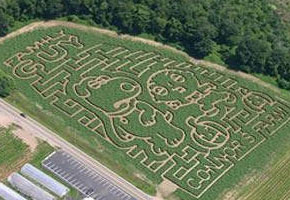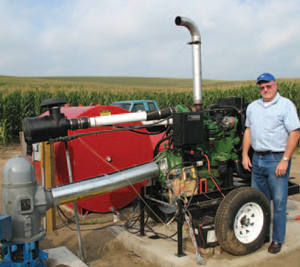 With rain, early freeze and overall cool summer conditions, 2009 harvest has become very challenging for some parts of the Corn Belt. This week’s Integrated Crop Management e-newsletter from Iowa State University highlights issues that need attention.
With rain, early freeze and overall cool summer conditions, 2009 harvest has become very challenging for some parts of the Corn Belt. This week’s Integrated Crop Management e-newsletter from Iowa State University highlights issues that need attention.
1. Corn Quality Issues:
– Frost-damaged corn often stops at 17-18% moisture (stopped at 20-22% in 2008 in Iowa). Expect low test weights due to immature kernel.
– Pay attention to stalk health, as you may want to harvest wetter corn first if lodged.
– Expect drydown costs about 5 cents per point of moisture removed. Remove 8 points down to 15% will cost about 40 cents per bushel plus weight shrink.
– Corn test weights below 54 lbs. after drying should not be stored into warm weather, and should be dried to less than 15% for storage of any duration.
– Scout for field molds problems, because they can create toxins and feed value concerns, possibly creating discounts.
2. Field Mold Issues:
– Cool, wet harvest conditions favor ear rot and stalk rot fungi. Harvest problem fields first to reduce ear loss due to ear rot and increased mycotoxin levels.
– Adjust harvest equipment to minimize kernel damage.
– Dry and cool the grain as quickly as possible to reduce further mold growth and toxin production.
– Expect end users to increase their level of grain quality grading.
– Test all questionable grain before feeding to livestock.
3. Storage Issues:
– The extra costs in additional handling and drying logistics will likely pay off in terms of avoiding spoiling losses later on.
– Check combine settings between fields for fines and cracked kernels because they accelerate spoilage.
– Fungi grows very fast in corn above 20% moisture, so get wet corn into aerated storage immediately–don’t let sit in truck or wagon overnight.
– Monitor wet corn weekly in storage. Airflow must be good, as problems can start to show up in February and March as temperatures rise.
– Options when wet corn exceeds drying capacity: 1. Dry to 17-18% then cool in storage bin; it’ll end up at 16% and good aeration can get it down to the needed 14% for midsummer storage. 2. Dry to 20%, cool in bin, hold wet corn for spring but not summer. 3. Dry in two passes–first down to 17-19% then rest of drying after harvest is over. (This requires more handling and logistics, but could be profitable if the market carry increases to encourage storage.)
– Decide which corn and bins will be kept into summer (your best corn of highest test weight that was harvested below 20% moisture).

 Whether you’re a novice at collecting harvest data or an old pro who could wallpaper his office with yield maps and more—you understand that more data layers beyond yield are necessary to add management decision value.
Whether you’re a novice at collecting harvest data or an old pro who could wallpaper his office with yield maps and more—you understand that more data layers beyond yield are necessary to add management decision value.
 Just when hay bales thought they could remain anonymous forever, along comes New Holland to give them a personality–or at least a brand! CropID, an individual bale identification system for large square bales, uses Radio Frequency Identification (RFID) technology in the twine to track bale atributes.
Just when hay bales thought they could remain anonymous forever, along comes New Holland to give them a personality–or at least a brand! CropID, an individual bale identification system for large square bales, uses Radio Frequency Identification (RFID) technology in the twine to track bale atributes.

 There are a number of companies now that specialize in helping people design and cut corn mazes in their fields for fun and profit, like
There are a number of companies now that specialize in helping people design and cut corn mazes in their fields for fun and profit, like  The largest official corn maze (at more than 40 acres) is in Dixon, Calif., but a Nebraska farmer is looking to break that Guinness Book record this year with his 54-acre maze. However, this year’s maze craze prize has to go to Bob Connors of Massachusetts, who created one based on the “Family Guy” TV show. Connors reportedly received permission from the Fox network to use the characters from the program and has invited Seth MacFarlane, the creator of the “Family Guy” series to visit the corn maze.
The largest official corn maze (at more than 40 acres) is in Dixon, Calif., but a Nebraska farmer is looking to break that Guinness Book record this year with his 54-acre maze. However, this year’s maze craze prize has to go to Bob Connors of Massachusetts, who created one based on the “Family Guy” TV show. Connors reportedly received permission from the Fox network to use the characters from the program and has invited Seth MacFarlane, the creator of the “Family Guy” series to visit the corn maze.
 The company has developed a new hydrated-ethanol fuel called EM60 (a mixture of 60% ethanol and 40% water) to combine with diesel fuel to power diesel engines. “Just like oil and water don’t mix, ethanol and diesel don’t mix,” Dickey said. So, they run two lines into the diesel engine. “The only time the ethanol, water and diesel are together is at the point of combustion and it really works well. The engine runs cooler, it runs more efficient and the emissions are reduced.”
The company has developed a new hydrated-ethanol fuel called EM60 (a mixture of 60% ethanol and 40% water) to combine with diesel fuel to power diesel engines. “Just like oil and water don’t mix, ethanol and diesel don’t mix,” Dickey said. So, they run two lines into the diesel engine. “The only time the ethanol, water and diesel are together is at the point of combustion and it really works well. The engine runs cooler, it runs more efficient and the emissions are reduced.”
 Grain yields must be corrected for moisture, otherwise wetter heavier grain will skew yields higher while drier, lighter grain will appear to decrease yields, says Matt Digman, University of Wisconsin Biological Systems Engineer.
Grain yields must be corrected for moisture, otherwise wetter heavier grain will skew yields higher while drier, lighter grain will appear to decrease yields, says Matt Digman, University of Wisconsin Biological Systems Engineer.